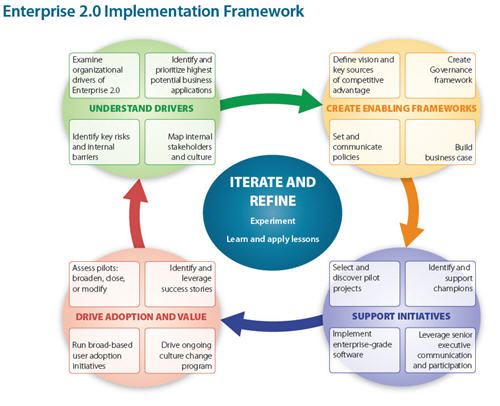Dion Hinchcliffe has written a useful post titled Going beyond the hype: Identifying Enterprise 2.0 best practices, reviewing some of the work in the space, and with the intent of building a broader catalog of best practices.
There is already valuable information in the post, and I’m sure Dion’s research will yield useful insights. However I have to say upfront don’t believe in the concept of “best practice” with regard to almost any business activity, particularly with Enterprise 2.0. Managers may love the idea of finding and emulating “best practice”, but trying to do that is a setup to failure.
Just as our individuality as people is often hidden, we are gradually understanding that every organization is different.
For the last year in my future enterprise speeches I have been describing how there are two layers to organizations: the commoditized layer of standardized processes, and the differentiated layer of ad-hoc networks. Best practices can useful apply to standardized processes, but far less so in facilitating connection and collaboration across diverse organizations.

Read more →

Social Media Strategy Framework in German – Social Media strategische Rahmenrichtlinien
By Ross DawsonContinuing our series of translations of Social Media Strategy Framework, today is German.
See the original post for the full overview of the Social Media Strategy Framework in English.
Click on image to download pdf
Please share this with any German speakers.
Also be sure to let me know if you can suggest any improvements to the translation.
Case study: hitting the Billboard charts by free online streaming of the album
By Ross DawsonI notice that Imogen Heap is continuing with the free streaming of her album Ellipse . And no doubt significantly because of the free streaming, Ellipse is charting at #5 on Billboard. It is a glorious album, though I think we can pretty definitely count the free streaming of the album on the web as a very effective strategy. Perhaps it will become commonplace to stream music for free in order to maximize sales.
I’d be keen to know the proportion of sales of this album and the songs on it online versus through CD. It would almost be surprising if she sold much in CDs at all, because her presence is so online..
I notice Imogen on Twitter now has over a million followers.
A bit tangentially, I just found this beautiful video of a beautiful song by Kate Havnevik, who I found through collaborative filtering and Imogen’s music. If you like Imogen you’ll absolutely like the extraordinary Kate. (note that it doesn’t start for 10 seconds)
Social Media Strategy Framework in Turkish – Sosyal Medya Strateji Çerçevesi
By Ross DawsonNow having launched version 2 of our Social Media Strategy Framework, we will release it in a variety of other languages.
Since I am giving the opening keynote at IPZ2009 Interactive Marketing Summit in Istanbul on 21 October, we will kick off with the Turkish version, and release the other translations over the next couple of weeks.
Click on image to download pdf
Please share this with any Turkish speakers.
Also be sure to let me know if you can suggest any improvements to the translation.
Updated version of Social Media Strategy Framework
By Ross DawsonOur Social Media Strategy Framework released a few months ago has been getting a lot of attention and downloads. Based on the feedback we’ve been getting, one of the things that was missing in the first Beta version was a clearer explanation of the structure of the diagram, which has two simultaneous flows down the left and right sides of the circle.
We have clarified that in this version, indicating that the left side shows the three steps in the process of ENGAGEMENT while the right side shows the three steps in STRATEGY DEVELOPMENT.
For a complete description of the diagram see the launch of the original framework.
Click on the image to download pdf
This is still a Beta and we will continue to develop this, so please give us your input on how to improve it!
Video of Bruce Sterling keynote on the dawn of the augmented reality industry
By Ross DawsonBruce Sterling , one of the founders of the cyberpunk genre, gave a fabulous keynote on the dawn of the augmented reality industry in Amsterdam when Layar’s Reality Browser was launched a few weeks ago.
Bruce says that augmented reality s a techno-visionary’s dream come true. He’s been following the space since it began at Boeing in 1992 and has been blogging steadily about augmented reality over the last few months. He covers the problems of the space as well as the massive opportunity. Bruce is a fantastic guy to hear from to get some perspective on what will become a massive industry and undoutededly substantially shift how we relate to “reality”.
Video: Bruce Sterling’s Keynote – At the Dawn of the Augmented Reality Industry from Maarten Lens-FitzGerald on Vimeo.
There is no such thing as best practice for Enterprise 2.0
By Ross DawsonDion Hinchcliffe has written a useful post titled Going beyond the hype: Identifying Enterprise 2.0 best practices, reviewing some of the work in the space, and with the intent of building a broader catalog of best practices.
There is already valuable information in the post, and I’m sure Dion’s research will yield useful insights. However I have to say upfront don’t believe in the concept of “best practice” with regard to almost any business activity, particularly with Enterprise 2.0. Managers may love the idea of finding and emulating “best practice”, but trying to do that is a setup to failure.
Just as our individuality as people is often hidden, we are gradually understanding that every organization is different.
For the last year in my future enterprise speeches I have been describing how there are two layers to organizations: the commoditized layer of standardized processes, and the differentiated layer of ad-hoc networks. Best practices can useful apply to standardized processes, but far less so in facilitating connection and collaboration across diverse organizations.
Read more →
ABC Radio National: Discussion on the future of influence
By Ross DawsonABC Radio National Future Tense this morning featured a discussion on the future of influence (click here for the podcast of both the radio program, and the unabridged discussion between Duncan Riley and myself). It kicks off with a quote from Chris Saad saying that influence and reputation are the currencies of the day, even more than attention.
When asked why we rebadged Future of Media Summit as Future of Influence Summit this year, I explained why “influence is the future of media”, and the five key trends in how influence is transforming society.
Duncan pointed to how the rise of Internet and social media means that influence can now be global. He also raised the issue of trust agents, and what it takes to be trusted as a publisher. We have more choice in what we look for, and so we need markers of credibility.
On the topic of business models for influence, I talked about two key ideas. The first is whether and how individuals can profit from their influence, and how that will develop. The second is the emergence of influence as a currency, and the companies that profiting from making influence explicit for companies.
Listen to the long version of the interview for more details.
The future of social networks and television distribution channels
By Ross DawsonLast weekend’s Sunday Telegraph published an article titled Tech to the future that looks at what’s coming next in consumer and social technologies. Unfortunately it isn’t available online, however here are the sections where I was quoted:
Now that we have as a society discovered sharing the content from our lives, the floodgates are open. Interoperability across social networks is evolving slowly, but is what we are coming to expect. Then later in the article:
Read more →
Will Influencism supplant Capitalism? The emergence of the influence economy
By Ross DawsonOne of the most interesting topics at the recent Future of Influence Summit was the emergence of business models for influence. Some particularly intriguing issues were raised in the Business Models for Influence and Reputation panel, suggesting that one of the key currencies of the future will be influence.
The panellists generally agreed that total revenue in the influence sector, including the companies represented on the panel (Rapleaf, Buzzlogic, Klout) is around US$100 million. The primary business model is providing insights to companies on who the influencers are in their customer base.
One example given is a hotel that asks guests checking in for their Twitter name, swiftly ascertaining how influential in social media they are, and treating them accordingly. If someone who has real reach is their guest, the hotel might upgrade them or otherwise treat them in a way that they are likely to rave about.
Read more →
A short video review of MD80 – smallest video recorder in the world (no not the iPod Nano)
By Ross DawsonA few months ago I bought an MD80 video recorder – supposedly the smallest in the world, and smaller than the iPod Nano, which David Pogue reviews today as the smallest camcorder.
I thought I’d do a video review of it, discussing both its use and demonstrating its video quality. In fact the biggest problem is the audio quality. I love how I can just clip it on my jacket and take ambient video as I walk around, but the audio is not good enough for doing interviews of people. A very nifty device and certainly with its uses, but not quite there.